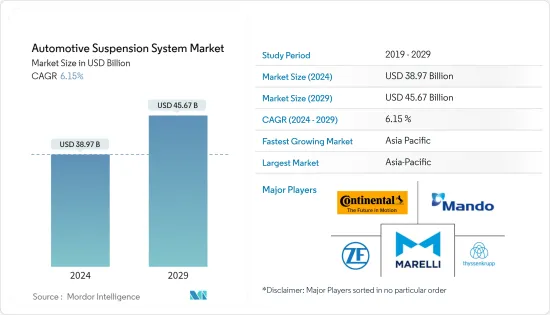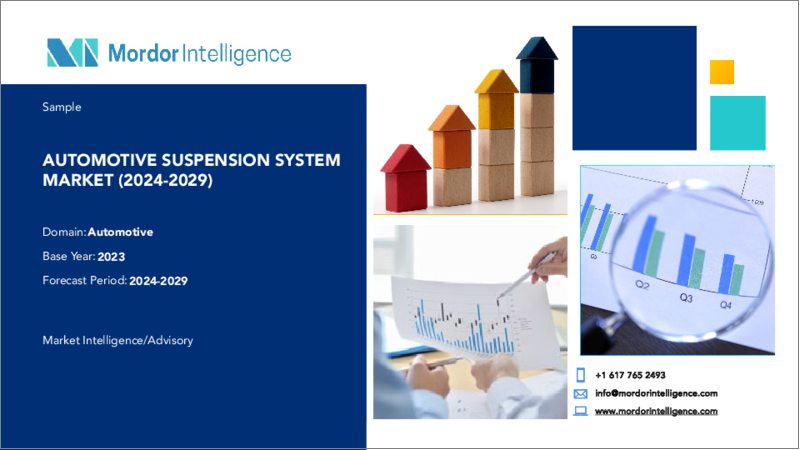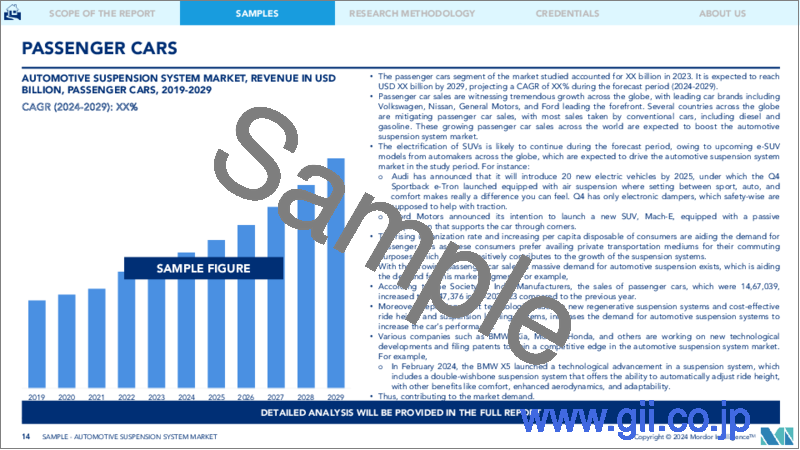|
|
市場調査レポート
商品コード
1536855
自動車用サスペンションシステム:市場シェア分析、産業動向・統計、成長予測(2024~2029年)Automotive Suspension System - Market Share Analysis, Industry Trends & Statistics, Growth Forecasts (2024 - 2029) |
||||||
カスタマイズ可能
適宜更新あり
|
|||||||
| 自動車用サスペンションシステム:市場シェア分析、産業動向・統計、成長予測(2024~2029年) |
|
出版日: 2024年08月14日
発行: Mordor Intelligence
ページ情報: 英文 100 Pages
納期: 2~3営業日
|
- 全表示
- 概要
- 目次
世界の自動車用サスペンションシステムの市場規模は、2024年に389億7,000万米ドルに達し、2024~2029年の予測期間中にCAGR 6.15%で成長し、2029年には456億7,000万米ドルに達すると予測されています。

自動車用サスペンションシステム市場は、ZF Friedrichshafen AG, Continental AG, Hyundai Mobisといった少数の大手世界企業が支配する、統合された状況を示しています。これらの企業は、広範な製品ポートフォリオ、技術的進歩、戦略的提携を通じて、市場における牙城を築いてきました。この市場の主な成長促進要因のひとつは、低燃費で環境に優しい自動車に対する需要の高まりです。高度なサスペンションシステムは、空気抵抗を減らし、全体的な性能を向上させることで、自動車の燃費を最適化する上で重要な役割を果たしています。快適でスムーズな乗り心地を好む傾向が強まっていることから、さまざまな車両セグメントで先進サスペンションシステムの需要が急増しています。2022年には、世界で約8,500万台の自動車が生産されました。中国は乗用車生産の世界的リーダーとして頭角を現し、約2,384万台の自動車を319万台の商用車とともに生産し、世界有数の乗用車生産国としての地位を固めました。中期的には、高級車需要とアクティブサスペンションシステムの普及が市場の成長を牽引すると予想されます。また、自動車の自律性の高まりも、センサーおよび電子ベースのサスペンションシステムの市場成長を促進すると予想されます。
市場が直面する主な課題の1つは、車両サスペンションシステムの複雑化であり、競争力を維持するためには研究開発への多額の投資が必要となります。加えて、先進的なサスペンションシステムの高価格は、特に手頃な価格が重要な懸念事項として残る新興市場において、その普及の障壁となる可能性があります。鉄鋼やアルミニウムなどの原材料価格の変動は、サスペンションシステムの生産コストに大きな影響を与え、メーカーのマージン圧迫につながる可能性があります。最後に、サスペンションコンポーネントの生産と廃棄に関する厳しい規制基準や環境上の懸念は、コンプライアンスと持続可能性の面で市場プレーヤーに課題をもたらす可能性があります。
最近、いくつかのOEMが、進化する消費者の嗜好と規制要件に対応するため、革新的なサスペンションシステムを発表しました。OEM各社は、ステアリングの安定性を向上させ、快適な乗り心地を提供するために、サスペンションシステムに斬新な技術を組み込む研究開発に投資しています。このような発展は、自動車用サスペンション市場を前進させると思われます。例えば、EXTは2023年4月、Eraフォークの先駆的なデュアルポジティブエアチャンバー設計を、Ariaアプリケーションのユニークな需要に対応するよう特別に調整し、アップデートしたものを開発しました。同様に、2022年11月、Monroeは北米で、OEの電子ユニットと直接交換する電子サスペンションを装備した高級欧州車向けに設計された新しいIntelligent Suspension RideSense製品を発売しました。
アジア太平洋と欧州は、自動車用サスペンションシステム市場で最も急成長すると予測されています。アジア太平洋では、中国が予測期間中も市場成長を牽引すると予想されます。
自動車用サスペンションシステム市場の動向
商用車販売の拡大が市場の需要を牽引
インフラと物流産業の成長も、商用車とそれに関連するサスペンションシステムの需要促進に大きな役割を果たしています。効率的な輸送と保管ソリューションへのニーズが高まる中、企業はより大規模な商用車への投資を進めており、市場の成長をさらに加速させています。
- 自動車用サスペンションシステム市場の成長に寄与している主な要因は、商用車の販売が増加していることです。企業が事業や物流網を拡大するにつれ、トラックやバンなど、商品やサービスを輸送するための商用車の需要が高まっています。このため、物資や乗客の安全で快適な輸送を確保するため、信頼性が高く効率的なサスペンションシステムのニーズが高まっています。
2022年、ドイツでは31万2,000台以上の商用車が販売または登録されました。販売台数は2020~2021年にかけて0.6%増加しました。同様に、フランスでは2022年に小型、中型、大型トラック・バスを含む39万7,519台の商用車が販売されました。
商用電気自動車の導入に向けた政府や自動車メーカーの取り組みが、自動車用サスペンション市場を牽引すると予想されます。ここ数年、電気商用車市場では、大手自動車メーカーが電動モビリティに向けた戦略を展開しており、世界のサスペンション市場を後押ししています。例えば
- 2023年7月、Hendricksonはインドでトレーラー用エアメカニカルサスペンションを発売し、現地の地形に対応することを目指しました。
- 2022年5月、ThyssenKruppはブラジルのサンパウロに、Springs & Stabilizers事業部門が運営する大型車用サスペンション製品の世界開発のための新しい技術センターを開設しました。ThyssenKruppはサンパウロとイビライトにSprings & Stabilizersの工場を持ち、自動車、バス、トラックなど様々なサイズの車両向けのSprings & Stabilizersを生産しています。
技術の進歩は、新車の発売や商用EVの世界の普及と相まって、予測期間中に自動車用サスペンションシステム市場を促進すると予想されます。環境問題への関心の高まりから、電気商用車市場は成長段階にあり、予測期間中に市場は大きく拡大すると予測されます。
予測期間中、アジア太平洋が最も高い成長を記録する見込み
アジア太平洋の自動車用サスペンションシステム市場は、予測期間中に収益面で大きな成長が見込まれます。同地域全体での乗用車や商用車を含む新車販売の増加が、市場の成長を後押ししています。
中国自動車工業会(CAAM)によると、2023年には中国で3,090万台以上の乗用車が販売され、アジア太平洋最大の市場となった。インドは同地域で2番目に大きな市場で、2023年の販売台数は約410万台でした。
この地域全体で生産施設を拡張している大手企業も、市場にチャンスをもたらす可能性があります。例えば
- 2023年12月、サスペンション技術のリーディングプロバイダーであるClearmotionは、中国の先駆的な電気自動車メーカーであるNIO社と提携しました。この提携の一環として、ClearmotionはNIOの次期電気自動車(EV)「ET9」に同社の先進サスペンション技術を供給します。この戦略的提携は、よりスムーズで快適な乗り心地を提供することで、NIOの顧客のドライビング体験を向上させることを目的としており、急成長するEV市場におけるクリアモーションの存在感をさらに確固たるものにするものです。
- 2023年4月、中国の自動車メーカーBYDは、自社開発のシャシーとサスペンションシステムを導入しました。この戦略的な動きは、BYDが自動車主要部品の垂直統合と独立に取り組んでいることを示すものです。この新しいシャシーとサスペンションシステムにより、BYDの電気自動車ラインアップは、運転体験の向上、安全性の向上、効率性の向上を実現し、世界のEV市場におけるBYDの地位をさらに強固なものにすると期待されています。
- Tenneco Inc.は2022年5月、高級ロードスターの2022年型メルセデスAMG SLクラスに、Monroe Intelligent Suspensionポートフォリオから最新のインテリジェントサスペンション技術を2つ採用すると発表しました。新モデルには、TennecoのCVSA2セミアクティブサスペンションまたは統合型CVSA2/キネティックサスペンションが採用されます。
このような取り組みにより、今後数年間は自動車生産が促進されることが予想され、その結果、地域全体で自動車用サスペンションシステムの需要が高まる可能性があります。
自動車用サスペンションシステム産業の概要
自動車用サスペンションシステム市場は適度に統合されており、Continental AG、Mando Corporation、ZF、Magneti Marelli、ThyssenKrupp AG、Mando Corporationといった大手企業が大きな市場シェアを占めています。製品革新と新市場への地理的拡大が、自動車用サスペンション市場におけるプレーヤーの成功に大きな役割を果たします。
- 2023年10月、McLaren AutomotiveはMonroeを独占サスペンションサプライヤーに指名しました。このパートナーシップは、McLarenのハイエンド車の性能とドライビング体験を向上させることを目的としています。サスペンション技術のリーディングカンパニーであるモンローは、マクラーレンのスポーツカー特有の要件に対応するカスタム設計のサスペンションコンポーネントとシステムをマクラーレンに提供します。この提携により、プレミアム自動車市場における両社のプレゼンスが強化され、革新的なサスペンション技術の継続的発展に貢献することが期待されます。
- 2023年8月、BWI GroupとClearmotionは、アクティブサスペンション事業を発展・成長させるための戦略的パートナーシップを締結しました。この提携は、BWI Groupのシャシーシステムに関する専門知識とClearmotionの高度なアクティブサスペンション技術を融合させ、車両の乗り心地とハンドリングを向上させる革新的なソリューションを実現することを目的としています。この共同取り組みは、両社の革新へのコミットメントと、アクティブサスペンションシステムの将来に対するビジョンの共有を示すものです。
- 2022年1月、ZF Friedrichshafen AGは商用車部門「Commercial Vehicle Solutions」を立ち上げ、自動車業界最大の商用車サプライヤーとなりました。
その他の特典
- エクセル形式の市場予測(ME)シート
- 3ヶ月間のアナリストサポート
目次
第1章 イントロダクション
- 調査の前提条件
- 調査範囲
第2章 調査手法
第3章 エグゼクティブサマリー
第4章 市場力学
- 市場促進要因
- 乗り心地の向上に対する需要の高まり
- 市場抑制要因
- 先進サスペンションシステムの初期コストの高さ
- 業界の魅力 - ポーターのファイブフォース分析
- 供給企業の交渉力
- 買い手/消費者の交渉力
- 新規参入業者の脅威
- 代替品の脅威
- 競争企業間の敵対関係の強さ
第5章 市場セグメンテーション(市場規模:米ドル)
- 部品タイプ
- コイルスプリング
- リーフスプリング
- エアスプリング
- ショックアブソーバー
- その他の部品タイプ
- タイプ
- パッシブサスペンション
- セミアクティブサスペンション
- アクティブサスペンション
- 車両タイプ
- 乗用車
- 商用車
- 地域
- 北米
- 米国
- カナダ
- その他の北米
- 欧州
- ドイツ
- 英国
- イタリア
- フランス
- その他の欧州
- アジア太平洋
- 中国
- インド
- 日本
- 韓国
- その他のアジア太平洋
- その他の地域
- 南米
- 中東・アフリカ
- 北米
第6章 競合情勢
- ベンダー市場シェア
- 企業プロファイル
- Continental AG
- Mando Corporation
- ZF Friedrichshafen AG
- Thyssenkrupp AG
- Tenneco Inc.
- Marelli Corporation
- Hyundai Mobis Co. Ltd
- Hitachi Astemo Ltd
- BWI Group
- Sogefi SpA
- KYB Corporation
- LORD Corporation
第7章 市場機会と今後の動向
- センサー・エレクトロニクスの統合
The Automotive Suspension System Market size is estimated at USD 38.97 billion in 2024, and is expected to reach USD 45.67 billion by 2029, growing at a CAGR of 6.15% during the forecast period (2024-2029).

The automotive suspension systems market exhibits a consolidated landscape, dominated by a few major global players such as ZF Friedrichshafen AG, Continental AG, and Hyundai Mobis. These companies have established a stronghold in the market through extensive product portfolios, technological advancements, and strategic collaborations. One of the primary growth drivers in this market is the increasing demand for fuel-efficient and eco-friendly vehicles. Advanced suspension systems play a crucial role in optimizing vehicle fuel efficiency by reducing air resistance and improving overall performance. The growing preference for comfortable and smooth rides has led to a surge in demand for advanced suspension systems across various vehicle segments. In 2022, approximately 85 million motor vehicles were produced globally. China emerged as the global leader in passenger car production, manufacturing approximately 23.84 million vehicles alongside 3.19 million commercial vehicles, solidifying its position as the foremost producer of passenger cars worldwide. Over the medium term, demand for luxury cars and the penetration of active suspension systems are expected to drive the market's growth. The rise in vehicle autonomy is also anticipated to drive the market's growth for sensor- and electronic-based suspension systems.
One of the primary challenges faced by the market is the increasing complexity of vehicle suspension systems, which requires significant investments in R&D to maintain competitiveness. Additionally, the high cost of advanced suspension systems can act as a barrier to their widespread adoption, particularly in emerging markets where affordability remains a key concern. The fluctuating prices of raw materials, such as steel and aluminum, can significantly impact the production costs of suspension systems, leading to margin pressures for manufacturers. Lastly, stringent regulatory norms and environmental concerns related to the production and disposal of suspension components can pose challenges for market players in terms of compliance and sustainability.
Several OEMs have recently introduced innovative suspension systems to cater to evolving consumer preferences and regulatory requirements. OEMs are investing in R&D to integrate novel technologies into suspension systems to improve steering stability and provide a comfortable ride. Such developments will drive the vehicle suspension market forward. For instance, in April 2023, EXT developed an updated adaptation of the Era fork's pioneering dual-positive air chamber design, specifically tailored to meet the unique demands of the Aria application. Similarly, in November 2022, Monroe launched new Intelligent Suspension RideSense products in North America designed for luxury European vehicles equipped with electronic suspensions as a direct replacement for OE electronic units.
Asia-Pacific and Europe are projected to be the fastest-growing automotive suspension system markets. In Asia-Pacific, China is expected to continue to drive market growth during the forecast period.
Automotive Suspension System Market Trends
Growing Sales of Commercial Vehicles to Drive the Demand in the Market
The growth of the infrastructure and logistics industry has also played a significant role in driving the demand for commercial vehicles and their associated suspension systems. With the increasing need for efficient transportation and storage solutions, businesses are investing in a larger fleet of commercial vehicles, further fuelling the market's growth.
- The primary factor contributing to the growth of the automotive suspension systems market is the increasing sales of commercial vehicles. As businesses expand their operations and logistics networks, there is a higher demand for trucks, vans, and other commercial vehicles to transport goods and services. This, in turn, leads to a greater need for reliable and efficient suspension systems to ensure the safe and comfortable transportation of goods and passengers.
In 2022, over 312,000 commercial vehicles were sold or registered in Germany. Sales increased by 0.6% from 2020 to 2021. Similarly, 397,519 commercial vehicles were sold in France in 2022, including light-duty, medium-duty, and heavy-duty trucks and buses.
The government and car manufacturers' initiatives to introduce commercial electric vehicles are expected to drive the automotive suspension market. In the past few years, the electric commercial vehicle market witnessed major automakers rolling out their strategies toward electric mobility, helping boost the global suspension market. For instance:
- In July 2023, Hendrickson launched air mechanical suspensions for trailers in India, aiming to cater to local terrain.
- In May 2022, ThyssenKrupp inaugurated a new technology center for the global development of suspension products for heavy vehicles in Sao Paulo, Brazil, operated by its Springs & Stabilizers business unit. ThyssenKrupp has Springs & Stabilizers factories in Sao Paulo and Ibirite, producing springs and stabilizer bars for various-sized vehicles, including cars, buses, and trucks.
Technological advancements, coupled with new vehicle launches and the increasing adoption of commercial EVs worldwide, are expected to propel the automotive suspension system market during the forecasted period. Due to the growing environmental concerns, the electric commercial vehicle market is in its growth phase, and the market is anticipated to expand significantly during the forecast period.
Asia-Pacific is Anticipated to Register the Highest Growth During the Forecast Period
The Asia-Pacific automotive suspension system market is expected to grow at a significant rate in terms of revenue during the forecast period. The rise in new vehicle sales, including passenger cars and commercial vehicles across the region, is boosting the market's growth.
As per the China Association of Automobile Manufacturers (CAAM), in 2023, over 30.9 million passenger cars were sold in China, making it the largest market in Asia-Pacific. India was the second-largest market in the region, with nearly 4.1 million unit sales in 2023.
Major companies expanding their production facilities across the region may also create an opportunity for the market. For instance,
- In December 2023, Clearmotion, a leading suspension technology provider, partnered with NIO, a pioneering Chinese electric vehicle manufacturer. As part of this collaboration, Clearmotion will supply its advanced suspension technology to NIO's upcoming Electric Vehicle (EV), the ET9. This strategic alliance aims to enhance the driving experience for NIO's customers by offering a smoother and more comfortable ride, further solidifying Clearmotion's presence in the rapidly growing EV market.
- In April 2023, Chinese automaker BYD introduced self-developed chassis and suspension systems. This strategic move showcases BYD's commitment to vertical integration and independence in key automotive components. The new chassis and suspension systems are expected to provide enhanced driving experiences, improved safety, and greater efficiency for BYD's electric vehicle lineup, further solidifying the company's position in the global EV market.
- In May 2022, Tenneco Inc. announced that the 2022 Mercedes-AMG SL-Class of luxury roadsters would feature two of the latest intelligent suspension technologies from its Monroe Intelligent Suspension portfolio. The new models will be offered with Tenneco's CVSA2 semi-active or integrated CVSA2/Kinetic suspension.
Such initiatives are expected to drive automotive production in the coming years, which, in turn, may drive the demand for automotive suspension systems across the region.
Automotive Suspension System Industry Overview
The automotive suspension system market is moderately consolidated, with leading players, such as Continental AG, Mando Corporation, ZF, Magneti Marelli, ThyssenKrupp AG, and Mando Corporation, accounting for a major market share. Product innovation and geographic expansion to new markets will play a major role in the success of any player in the automotive suspension market.
- In October 2023, McLaren Automotive appointed Monroe as its exclusive suspension supplier. This partnership aims to enhance McLaren's high-end vehicles' performance and driving experience. Monroe, a leading suspension technology company, will provide McLaren with custom-engineered suspension components and systems that cater to the unique requirements of McLaren's sports cars. This collaboration is expected to strengthen both companies' presence in the premium automotive market and contribute to the ongoing development of innovative suspension technologies.
- In August 2023, BWI Group and Clearmotion formed a strategic partnership to develop and grow their active suspension business. This collaboration aims to combine BWI Group's expertise in chassis systems and Clearmotion's advanced active suspension technology, resulting in innovative solutions for improved vehicle ride and handling. This joint effort showcases both companies' commitment to innovation and shared vision for the future of active suspension systems.
- In January 2022, ZF Friedrichshafen AG launched a commercial vehicle division named Commercial Vehicle Solutions, which makes the company the largest commercial vehicle supplier in the automotive industry.
Additional Benefits:
- The market estimate (ME) sheet in Excel format
- 3 months of analyst support
TABLE OF CONTENTS
1 INTRODUCTION
- 1.1 Study Assumptions
- 1.2 Scope of the Study
2 RESEARCH METHODOLOGY
3 EXECUTIVE SUMMARY
4 MARKET DYNAMICS
- 4.1 Market Drivers
- 4.1.1 Increasing Demand for Enhanced Ride Comfort
- 4.2 Market Restraints
- 4.2.1 High Upfront Cost of Advanced Suspension Systems
- 4.3 Industry Attractiveness - Porter's Five Forces Analysis
- 4.3.1 Bargaining Power of Suppliers
- 4.3.2 Bargaining Power of Buyers/Consumers
- 4.3.3 Threat of New Entrants
- 4.3.4 Threat of Substitute Products
- 4.3.5 Intensity of Competitive Rivalry
5 MARKET SEGMENTATION (Market Size in Value (USD))
- 5.1 Component Type
- 5.1.1 Coil Spring
- 5.1.2 Leaf Spring
- 5.1.3 Air Spring
- 5.1.4 Shock Absorber
- 5.1.5 Other Component Types
- 5.2 Type
- 5.2.1 Passive Suspension
- 5.2.2 Semi-active Suspension
- 5.2.3 Active Suspension
- 5.3 Vehicle Type
- 5.3.1 Passenger Cars
- 5.3.2 Commercial Vehicles
- 5.4 Geography
- 5.4.1 North America
- 5.4.1.1 United States
- 5.4.1.2 Canada
- 5.4.1.3 Rest of North America
- 5.4.2 Europe
- 5.4.2.1 Germany
- 5.4.2.2 United Kingdom
- 5.4.2.3 Italy
- 5.4.2.4 France
- 5.4.2.5 Rest of Europe
- 5.4.3 Asia-Pacific
- 5.4.3.1 China
- 5.4.3.2 India
- 5.4.3.3 Japan
- 5.4.3.4 South Korea
- 5.4.3.5 Rest of Asia-Pacific
- 5.4.4 Rest of the World
- 5.4.4.1 South America
- 5.4.4.2 Middle East and Africa
- 5.4.1 North America
6 COMPETITIVE LANDSCAPE
- 6.1 Vendor Market Share
- 6.2 Company Profiles*
- 6.2.1 Continental AG
- 6.2.2 Mando Corporation
- 6.2.3 ZF Friedrichshafen AG
- 6.2.4 Thyssenkrupp AG
- 6.2.5 Tenneco Inc.
- 6.2.6 Marelli Corporation
- 6.2.7 Hyundai Mobis Co. Ltd
- 6.2.8 Hitachi Astemo Ltd
- 6.2.9 BWI Group
- 6.2.10 Sogefi SpA
- 6.2.11 KYB Corporation
- 6.2.12 LORD Corporation
7 MARKET OPPORTUNITIES AND FUTURE TRENDS
- 7.1 Integration of Sensors and Electronics






